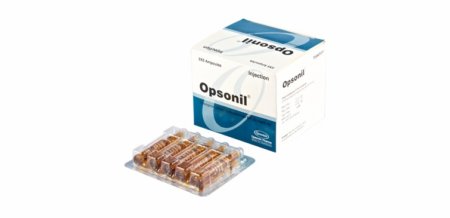
Type:1 amps
Generic Name:Chlorpromazine Hydrochloride
Manufacturer:Opsonin Pharma Limited
Price:৳4.00
Schizophrenia, Bipolar disorder, Anxiety, Psychoses, Delirium, Porphyria, Hiccups, Nausea, Vomiting
May be taken with or without food. May be taken w/ meals to reduce GI discomfort. Direct IV injection is only for control of nausea and vomiting during surgery and for adjunctive treatment of tetanus IV infusion is only for adjunctive treatment of intractable hiccups in adults IV Administration Direct IV injection: Dilute with NS to concentration no higher than 1 mg/mL, and administer at rate of 1 mg/min in adults and 0.5 mg/min in children; avoid administering undiluted drug IV infusion: Add appropriate dose to 500-1000 mL of NS, and administer slowly
Schizophrenia, Psychotic Disorders PO: 30-75 mg/day divided q6-12hr initially; maintenance: usually 200 mg/day (up to 800 mg/day in some patients; some patients may require 1-2 g/day) IV/IM: 25 mg initially, followed PRN with 25-50 mg after 1-4 hours, then increased to maximum of 400 mg q4-6hr until patient is controlled; usual dosage 300-800 mg/day Nausea & Vomiting PO: 10-25 mg q4-6hr PRN IV/IM: 25-50 mg q4-6hr PRN Preoperative Apprehension 25-50 mg PO 2-3 hours before surgery 12.5-25 mg IM 1-2 hours before surgery Intraoperative Sedation 12.5 IM q30min or 2 mg IV q2min; total dose not to exceed 25 mg Intractable Hiccups 25-50 mg PO q6-8hr; if hiccups persist after 2-3 days of oral therapy, administer 25-50 mg IM q3-4hr; if symptoms persist, administer 25-50 mg by slow IV infusion with patient lying flat in bed; monitor BP Acute Intermittent Porphyria 25-50 mg PO q6-8hr Elderly: Initially, 1/3-½ the normal adult dose.
Behavioral Disorders, Hyperactivity >6 months: 50-100 mg/day PO/IM; 200 mg/day or more may be necessary for older hospitalized patients; for outpatients, may administer 0.55 mg/kg q4-6hr PRN Nausea & Vomiting >6 months: 0.5-1 mg/kg PO/IM q6-8hr PRN Preoperative Apprehension >6 months: 0.55 mg/kg PO/IM 1-2 hours before surgery <6 months: Safety and efficacy not established
Do not use in patients with known hypersensitivity to phenothiazines. Do not use in comatose states or in the presence of large amounts of central nervous system depressants (alcohol, barbiturates, narcotics, etc.).
Chlorpromazine is a neuroleptic that acts by blocking the postsynaptic dopamine receptor in the mesolimbic dopaminergic system and inhibits the release of hypothalamic and hypophyseal hormones. It has antiemetic, serotonin-blocking, and weak antihistaminic properties and slight ganglion-blocking activity.
Some patients exposed chronically to antipsychotics will develop tardive dyskinesia, Chlorpromazine should be administered cautiously to persons with cardiovascular, liver or renal disease. There is evidence that patients with a history of hepatic encephalopathy due to cirrhosis have increased sensitivity to the CNS effects of chlorpromazine (i.e., impaired cerebration and abnormal slowing of the EEG). Because of its CNS depressant effect, chlorpromazine should be used with caution in patients with chronic respiratory disorders such as severe asthma, emphysema and acute respiratory infections, particularly in children (1 to 12 years of age). Because chlorpromazine can suppress the cough reflex, aspiration of vomitus is possible. Lactation: Drug enters breast milk; not recommended (American Academy of Pediatrics [AAP] states that this is "of concern")
Extrapyramidal symptoms. Tardive dyskinesia (on long-term therapy). Involuntary movements of extremities may also occur. Dry mouth, constipation, urinary retention, mydriasis, agitation, insomnia, depression and convulsions; postural hypotension, ECG changes. Allergic skin reaction, amenorrhoea, gynaecomastia, weight gain. Hyperglycaemia and raised serum cholesterol. Potentially Fatal: Agranulocytosis. Instantaneous deaths associated with ventricular tachyarrhythmias. Marked elevation of body temperature with heat stroke. Neuroleptic malignant syndrome, extrapyramidal dysfunction.
Pregnancy category: C; neonates exposed to antipsychotic drugs during 3rd trimester of pregnancy are at risk for EPS or withdrawal symptoms after delivery; these complications vary in severity, with some being self-limited and others necessitating ICU support and prolonged hospitalization Lactation: Drug enters breast milk; not recommended (American Academy of Pediatrics [AAP] states that this is "of concern")
Potentiation of anticholinergic effects of antiparkinson agents and TCAs may lead to an anticholinergic crisis. Additive orthostatic hypotensive effect in combination with MAOIs. Reverses antihypertensive effect of guanethidine, methyldopa and clonidine. Potentially Fatal: Additive depressant effect with sedatives, hypnotics, antihistamines, general anaesthetics, opiates and alcohol.